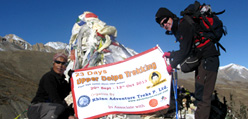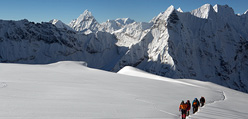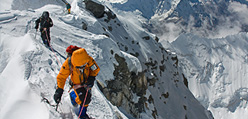Email : info@nepaltrekkingpackage.com
+977 - 01 - 4701300
Equipment to Bring
Equipment
One of the most important elements of preparing for a trek is making sure you have the right equipment. Rhino Adventure Treks is able to provide you with equipment for hire or purchase, but alternatively you can stock up before you leave home, or even in Kathmandu’s main tourist shopping bazaar, Thamel. Here you will find all the equipment you’ll ever need (and a lot of things you’ll never need) at a fraction of the cost of prices in the West. Much of the clothing and equipment here is falsely branded, however, they are often of sufficient quality for expeditions. But, buyer beware!
We advise you to take the issue of which items of clothing to bring very seriously. Too little, and you’ll be very cold, especially at high altitude. Too much, and you (or your porter) will find carrying the load to be extremely burdensome. We advise that you bring layers of lighter clothes for most treks below 4,000m, which can be easily put on or taken off throughout the day without needing to stop for too long, as and when the temperature changes. For treks at higher altitudes, layers are still a good idea, but in the evenings you will want very warm clothes to get you through.
Clothing and footwear
Trainers and tennis shoes will not give you the ankle support you need while trekking, but it’s also true that for most treks, you won’t need highly technical boots. A trainer-boot hybrid is often all that is necessary – look for ankle support and lightweight shoes, preferably ones which offer Gore-Tex or similar waterproof, breathable technology. Be sure to break your trekking footwear in before embarking upon your trek, and consider packing them in your hand luggage when flying – they are the most important piece of kit you will take and may be hard to replace to your exact specifications. You should also consider packing a pair or lightweight shoes, trainers or even flip-flops, useful for walking around camps and for using bathrooms.
A pair of light cotton trousers is advisable, as are a pair of knee length (or longer shorts), for hot trekking days. Avoid leggings as they may cause offence to the more conservative people in Nepali villages. Jeans, while comfortable, are not particularly practical, and if they become wet from the rain, will be very heavy to wear or carry.
A down jacket is a worthwhile investment, particularly at high altitudes or during Winter. Temperatures can stoop well below freezing, and a down jacket is the best way to combat the cold while also having the advantage of being relatively light and easy to pack.
A pair of breathable waterproof trousers and, more importantly, a jacket, is highly recommended in case of rain.
Your choice of socks is as important as your choice of trekking boots. It is advisable to buy thick socks as well as some liner socks, which will help cushion your feet and prevent painful blisters. You should avoid buying nylon, and bring around three pairs of each – you will be able to was them easily by hand when you take a shower in the evening, and this will cut down on needless clutter in your backpack.
A thick jumper or fleece is also advisable, but be sure that your waterproof jacket can accommodate the extra bulk – that way you can stay both warm and dry!
It is well worth bringing a simple, thin track suit, which will be comfortable to change into after a long day of trekking and much warmer to sleep in than pyjamas.
Other clothing items
- Thin t-shirt.
- Thick t-shirt.
- Long sleeved shirts to prevent sunburn, and protect your skin from insect bites.
- Underwear – thermal underwear and vests for high altitudes.
- Warm hat.
- Swimsuit – to be warn if you visit any hot springs!
- Handkerchiefs.
- Sun hat.
Equipment
- One small day sack, around 30 litres, for the trek.
- Another case or bag, in which you can store the things you don’t need for the trek. This should be lockable, so bring padlocks too, and you can store this at your hotel in Kathmandu or Pokhara, or at the Rhino office in Thamel.
- Water bottle.
- Penknife – don’t forget to pack this in your hold luggage – it will be confiscated if found in your hand luggage!
- Sunglasses.
- Personal first aid kit.
- Head torch.
- Plastic bags – these can be useful for all kinds of things: keeping important items or documents dry, separating dirty laundry from clean clothes, etc.
- Sleeping bag – this should be a four season bag, which will be useful in all temperatures. You can rent one from us in Kathmandu if you prefer, but you should also consider bringing a sleeping bag liner, especially if you are staying in lodge accommodation, where bedsheets are not always 100% clean.
- Toiletries – try to keep cosmetics to a minimum, but you should definitely bring a toothbrush and toothpaste, soap, shampoo, wet wipes and toilet paper.
- Sun cream and lip salve.
- Iodine tablets for water sterilisation.
Personal effects
- Money belt, neck purse or zippable pockets.
- Passport.
- Travellers' cheques and cash, credit cards.
- Travel insurance certificate.
- Alarm clock.
- Reading material.
- Writing material – paper, pens, and envelopes.
- Playing cards – or chess, dice, travel scrabble, travel monopoly, etc.
- Umbrella - not essential but useful for sun and rain. Buy in country before start of trek.
- Lighter – for candles on the trek, and burning toilet paper.
- Earplugs - Very useful for ensuring a good night’s sleep when near villages with noisy dogs.


